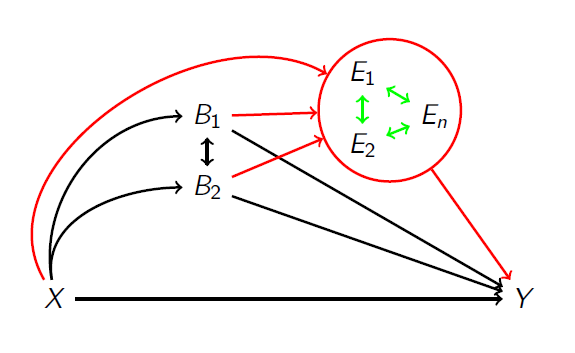6.3 Integrating environmental mixtures in mediation analysis
Mediation analysis is a common approach to investigate causal pathways relating the exposure(s) and the outcome of interest. When evaluating environmental mixtures, there are several settings where our mixture of interest is only a component of an even larger picture. For example, we may want to integrate sources of exposures, or evaluate the contribution of environmental chemicals to health disparities. Our mixture, in these cases, is a mediator of a given \(X-Y\) association. In other settings, we might be interested in the mechanisms through which the mixture affects the outcome. The mixture here is the exposure in a mediation model. We can also have several mixtures affecting each other, or potential causal dependencies within the mixture.
In the general framework of exposome analysis, the underlying hypothesis is that a set of multiple exogenous exposures (the external exposome) affects the complex set of biomarkers at the microbiome level (the internal exposome), thus contributing to the development of health effects (Figure 6.1). This structure is explicitly making assumptions in terms of mediation:

Figure 6.1: The exposome concept as presented in Vrijheid et al. 2014
The DAG in Figure 6.2 presents a common situation where researchers might be interested in evaluating an integrative framework for environmental exposures (E), lifestyle and behavioral factors (B), and social constructs (X), which may be complex but has the potential to elucidate mechanisms through which diseases are caused. This framework was presented in an introductory publication by Bellavia et al. (2018).

Figure 6.2: Bellavia et al. Env. Epi. 2018
Integrating methods for environmental exposures into mediation analysis has been the goal of several recent papers, which the reader could refer to for further details (Bellavia, James-Todd, and Williams (2019)), (Blum et al. (2020)), (Devick et al. (2018)). These methods have been largely unexplored in applied studies and may represent a critical tool to further identify the mechanisms through which the exposome affects human health. A recent R function was also developed to integrate BKMR into a mediation analysis context (Wang et al. (2020)).